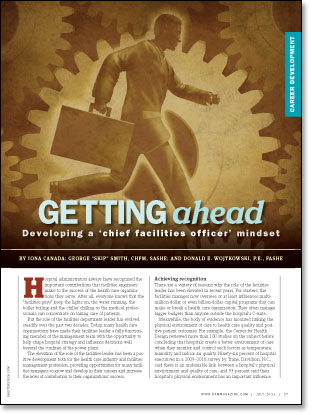 Hospital administrators always have recognized the important contributions that facilities engineers make to the success of the health care organizations they serve. After all, everyone knows that the "facilities guys" keep the lights on, the water running, the boiler boiling and the chiller chilling so the medical professionals can concentrate on taking care of patients.
Hospital administrators always have recognized the important contributions that facilities engineers make to the success of the health care organizations they serve. After all, everyone knows that the "facilities guys" keep the lights on, the water running, the boiler boiling and the chiller chilling so the medical professionals can concentrate on taking care of patients.
But the role of the facilities department leader has evolved steadily over the past two decades. Today, many health care organizations have made their facilities leader a fully functioning member of the management team with the opportunity to help shape hospital strategy and influence decisions well beyond the confines of the power plant.
The elevation of the role of the facilities leader has been a positive development both for the health care industry and facilities management profession, providing opportunities for many facilities managers to grow and develop in their careers and increase the level of contribution to their organizations' success.
Achieving recognition
There are a variety of reasons why the role of the facilities leader has been elevated in recent years. For starters, the facilities manager now oversees or at least influences multimillion-dollar or even billion-dollar capital programs that can make or break a health care organization. They often manage bigger budgets than anyone outside the hospital's C-suite.
Meanwhile, the body of evidence has mounted linking the physical environment of care to health care quality and positive patient outcomes. For example, the Center for Health Design reviewed more than 100 studies on the subject before concluding that hospitals create a better environment of care when they monitor and control such factors as temperature, humidity and indoor air quality. Ninety-six percent of hospital executives in a 2009–2010 survey by Trane, Davidson, N.C., said there is an undeniable link between a hospital's physical environment and quality of care, and 93 percent said their hospital's physical environment has an important influence on the total patient experience.
Along with this has come the recognition that facilities managers and their teams have more daily opportunities to ensure that the hospital is a safe, comfortable and healing place than any other group. At SSM Health Care–St. Louis, this idea inspired the facilities team's unofficial motto, "A healing environment is any environment that inspires the confidence of patients that they are in the right place at the right time receiving the right treatment by the right people." The physical environment plays an important part in reinforcing this concept.
Finally, improving the health, comfort and safety of their facilities helps hospitals attract and retain patients, caregivers and administrative staff, which can lead to a healthier bottom line.
The research company Harris Interactive, New York, found that patients rate a hospital's physical environment as the second most important factor in their satisfaction, behind clinical care. Additionally, a study by New York-based PricewaterhouseCoopers (PwC) recently concluded that well-designed and maintained facilities enhance caregivers' performance and motivation, which leads to better patient outcomes. PwC also found that nurses consider a hospital's physical environment when choosing an employer.
Recognizing that physicians often choose a hospital based in part on the environment of care, consulting firm Merritt, Hawkins & Associates, Irving, Texas, noted that attracting an affiliated cardiologist can add $2.5 million to a facility's annual revenue.
A strategic role
Some health care organizations consider the facilities department to be an essential service group, but have not yet recognized the full potential of engaging the facilities leader as a functioning member of the senior leadership team. As a result, hospital administrators and their staffs miss out on the unique perspective that a facilities professional can bring.
For example, health care reform is creating a wide range of challenges for health care organizations nationwide. Key among them is the drive to reduce costs and improve productivity without adversely affecting the quality of care provided to patients. A recent survey by McKinsey & Company, New York, estimated that about three-fourths of hospital executives are focused on reducing costs and more than half also are looking for productivity improvements.
With cost pressures mounting, there are fewer hospital construction projects on the drawing board than in recent memory. As a result, many hospitals will need to meet the challenges of increasing regulation, shrinking budgets, changing demographics and expanding patient loads without investing in new buildings or major modifications.
At Catholic Health Initiatives, Englewood, Colo., for example, the facilities teams are focused on making sure that the hospital system's infrastructure is serviceable and on investing capital resources in ways that contribute to improvements in quality of care and patient outcomes.
Facilities managers are uniquely qualified to weigh in on these critical decisions and their broader implications for the organization and its ability to fulfill its patient care mission. They are experts on systems reliability, life-cycle operating costs, deferred maintenance, energy conservation, environmental compliance and a wide range of other relevant topics.
They also have the information and credibility to make the case for prudent, targeted capital spending, even during challenging and uncertain times for the health care industry. For example, facilities professionals are taking a leadership role in implementing high-performance hospital strategies that can improve operating effectiveness, reduce total life-cycle cost of ownership and pay for themselves many times over during the decades-long life of a typical hospital building.
Finally, the expanding role of the health care facilities manager has opened new doors for personal and professional development. Whether they are members of the senior management team, advisers to hospital decision-makers or implementers of tactics that directly support the hospital mission, facilities leaders have a front-row seat to the decision-making process and the opportunity to make a real difference for their organization and its stakeholders.
Opportunities to expand
Facilities managers cannot sit back and wait for their organizational role to expand and mature. Most senior facilities leaders have found that the best way to build influence, add value and ultimately advance in the organization is to adopt a "chief facilities officer" mindset, regardless of their actual title or position on the organizational chart.
Following are some strategies that health care facilities managers can adopt if they want to have a greater impact on their organizations:
Build credibility with excellent performance. There is no substitute for doing a great job. Facilities managers gain respect and influence in their organizations by being good supervisors, communicators, planners, budgeters and problem solvers.
Grow continuously in technical expertise. The facilities manager should be the organization's thought leader on a wide range of subjects from high-performance hospital concepts to the latest paving materials and beyond. He or she must stay current on new technologies and trends, read extensively, pursue relevant degrees and certifications, and attend courses sponsored by the American Society for Healthcare Engineering (ASHE) and other professional societies.
Become an innovator. The best managers single themselves out as top performers by speaking up and taking on tough assignments that contribute to the organization's success. They stay on top of industry trends, think outside the box and look for new and innovative ways to apply the expertise of the facilities department to achieve larger organizational goals.
Understand the big picture. It is impossible for facilities leaders to demonstrate their right to a seat at the executive table unless they fully understand the organization's vision, mission and goals. Facilities managers must be able to directly relate everything their department does to the organization's bigger picture.
Get down to business. The most effective facilities leaders understand important business concepts and are able to present their ideas in ways that resonate with decision-makers. They are able to use data to show how their recommendations make sense in the larger scheme of things and position the organization for success.
Get involved. Facilities managers seldom get ahead by hanging out in the boiler room. They need to meet regularly with stakeholders to understand their needs better and look for early warning signs of problems. They need to build productive relationships inside and outside the health care organization. It is also a good idea for facility managers to join professional organizations such as ASHE to find mentors and to get involved in community organizations to broaden their view of the world and expose themselves to different perspectives.
Enormous opportunities
Today's hospitals and health care systems expect more of their facilities leaders than ever before. The financial pressures caused by health care reform and other factors have focused attention on opportunities to reduce life-cycle energy and operating costs while also improving the physical environment of care.
Social pressures and good citizenship make improving environmental performance an imperative for responsible health care organizations. Hospitals also recognize the role of facilities professionals in creating a safer, healthier, more comfortable physical environment that will meet the needs of patients, medical staff and hospital employees.
As operating costs and budgets shrink, these and other factors make these challenging times for today's health facilities professionals. But they also create enormous opportunities for proactive facilities managers to demonstrate value to their organizations and advance their careers by embracing "chief facilities officer" thinking.
Iona Canada is corporate manager of health care business development for Trane, a global provider of indoor comfort systems and services and a brand of Ingersoll Rand,Davidson, N.C. George "Skip" Smith, CHFM, SASHE, is president of the American Society for Healthcare Engineering (ASHE) and vice president, supply chain/clinical engineering and facility management, for Catholic Health Initiatives in Denver. Donald E. Wojtkowski, P.E., FASHE, is an ASHE past president and executive director of design, construction and facilities management for SSM Health Care—St. Louis. They can be reached at ICanada@trane.com, skipsmith@catholichealth.net and Donald_Wojtkowski@ssmhc.com, respectively.
| Sidebar - Speaking the language of business |
| Many facilities managers have engineering degrees and most have years — sometimes decades — of technical experience. As a result, they tend to speak the language of operating parameters and electrical resistivity. They also need to become fluent in the language of business. Proposing innovative ideas or capital improvements with multimillion-dollar price tags requires facilities managers to build and present an effective business case to chief executive officers, chief financial officers and other decision-makers who most likely have extensive business training and experience. The principles of effective communication require that the presenter use an audience-centric approach, which means emphasizing concepts and developing proof-points that will resonate with a business audience. By necessity, the most effective facilities managers become adept at identifying a problem or opportunity, gathering and analyzing relevant information, developing options based on the data, estimating implementation costs, justifying and recommending a preferred path forward, and asking for approval to proceed. Most importantly, managers must be able to describe clearly how their recommended approach supports broader organizational goals and makes sense for a particular audience. For example, an executive with a strong financial background is more likely to support a proposal that emphasizes an attractive return on investment than one that focuses on saving kilowatts. On the other hand, a lawyer probably would be more impressed by data that shows how air-quality improvement will reduce legal exposure than by the size of the microbes the new filters will trap. There are many ways that facilities managers can expand their general business knowledge, including taking business, management or financial courses at local colleges or universities, many of which offer specific courses for nonfinancial professionals. It also may be helpful to seek the advice of marketing, finance and legal colleagues. |
| Sidebar - Linking department goals to the hospital mission |
| In successful health care organizations, facilities managers must become adept at linking their department's goals to outcomes that support the hospital's ability to achieve its mission. To do this, facilities managers need to gather and study such important documents as vision and mission statements, strategic plans and annual operating plans. They also can benefit from focused discussions with senior executives, department heads and other stakeholders who can help them to better understand the organization's top priorities and how the facilities department can contribute to achieving them. Facilities managers are missing an opportunity if they cannot directly trace each goal in their annual and multiyear facilities plans to their respective organization's mission, goals and priorities. The notion of tying facilities department activities to the hospital's ability to carry out its primary mission is the essence of the high-performance hospital concept. As part of the process of developing a high-performance hospital building approach, the facilities team identifies mission-critical building systems such as electrical; plumbing; heating, ventilating and air conditioning; and other systems. Mission-critical systems are those that seriously would disrupt critical hospital operations if they were allowed to fail. The team then calculates the costs of a system failure, including the cost of repair or replacement of a major system. But the "real" costs also include the disruption caused by an unplanned system failure that could cause a hospital to close a department, a floor or a whole wing for hours or even days. Such calculations help the facilities manager put decisions to defer maintenance, for example, into perspective by helping the organization realize the potential impact of an unplanned system failure on the hospital's bottom line and, more importantly, on standards of care. |





